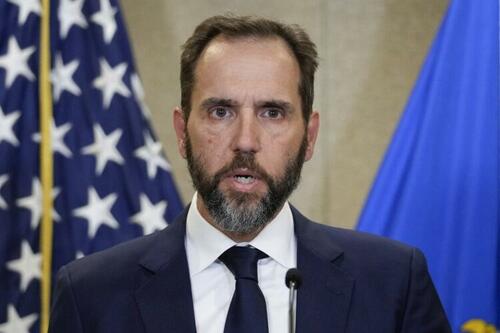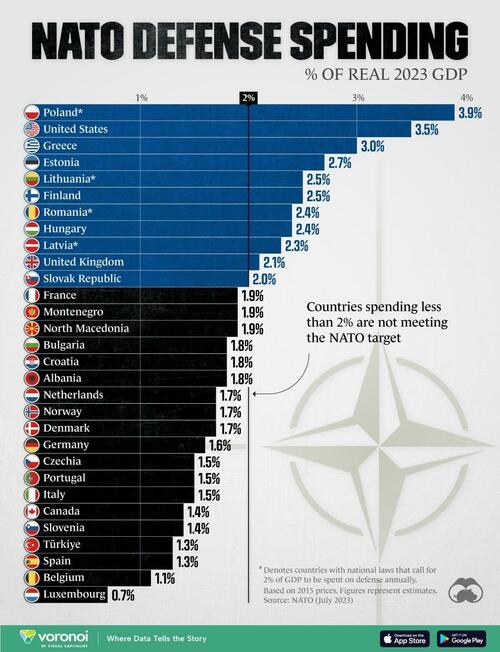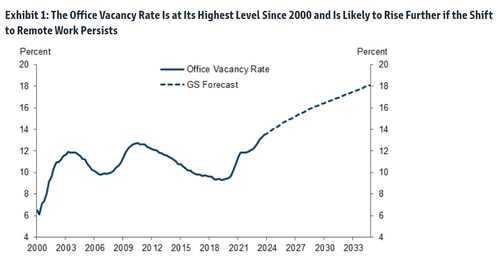Authored by Julie Kelly via RealClearInvestigations,
Washington glitterati assembled at the John F. Kennedy Center for the Performing Arts in October to celebrate federal employees making a difference in government. Hosted by CNN anchor Kate Bolduan, the black-tie affair featured in-person appearances by top Biden White House officials including Chief of Staff Jeffrey Zients, Deputy Attorney General Lisa Monaco, and Secretary of Agriculture Thomas Vilsack.

Judge Florence Pan, who now has key Trump issues such as presidential immunity before her in court … U.S. District Court for the District of Columbia/Wikimedia
Midway through the evening’s festivities, Max Stier, president of the group sponsoring the event – the Partnership for Public Service, a $24 million nonprofit based in Washington that recruits individuals to work in the civil service – took the stage to thank his high-profile guests.
“Great leaders are the heart and soul of effective organizations,” Stier said, “which is why I am so thankful to see so many of our government’s amazing leaders here tonight.”
Stier also acknowledged one federal employee, his wife, Judge Florence Y. Pan, who sits on the Court of Appeals for the District of Columbia. Pan would soon need no introduction. Earlier this month she made headlines by asking Donald Trump’s lawyers whether the presidential immunity he sought in connection with alleged Jan. 6 crimes was absolute.
“Could a president order SEAL Team Six to assassinate a political rival?” Pan asked Trump lawyer John Sauer. “That’s an official act – an order to SEAL Team Six?” she clarified.

… while her husband, Democrat insider Max Stier, continues campaigning against Trump after emerging as a key accuser of his former Yale classmate and present Trump-appointed Supreme Court Justice Brett Kavanaugh. Business Wire
Although the back and forth between Pan and Sauer was inconclusive as to the question about a president’s criminal liability, many mainstream outlets misconstrued the exchange while lionizing Pan for posing a question that they then used to advance their description of Trump as a lawless menace. The exchange, which Pan prompted when she posed the pre-arranged hypothetical at beginning of the hearing, has raised new questions about the impartiality of judges hearing politically charged cases.
For months progressives have been insisting that Supreme Court Justice Clarence Thomas should recuse himself from any case that involves Trump because of his wife Ginni Thomas’ political involvement and participation in the events of Jan. 6. Those same interests have yet to express similar worries about Pan’s objectivity, despite her husband’s longtime political activism and current opposition to another Trump presidency.
Power couples are the lifeblood of Washington so it’s not unusual for political activists, judges, and White House bigwigs to rub elbows at fancy soirees like the October gala at the Kennedy Center. But Max Stier’s longtime ties to the Democratic Party, his access to key Biden administration officials, and his suggestion that Trump represents a threat to democracy at the same time his wife is handling sensitive matters related to the Department of Justice’s prosecution of the former president should raise questions about her impartiality.
A member of Bill Clinton’s legal team during the Monica Lewinsky scandal, Stier, 57, has been a Democratic Party fixture for nearly three decades. Since 2001, he has run the Partnership for Public Service, which is funded by some of the most generous benefactors of progressive causes including the Gates Foundation, Democracy Fund, and the Ford Foundation. In 2020, the Partnership launched an effort tied to the Diversity, Equity, and Inclusion (DEI) movement, pledging to demand what it considers greater diversity in government agencies and institutions.
In a letter to mark the group’s 20-year anniversary, Stier lamented the country’s democratic “crisis” caused by “a violent insurrection against Congress and growing suspicions about the results of a legitimate election.”

Liberal media and Democrats see big conflicts of interest in conservative Justice Clarence Thomas and his activist wife, Ginni. They seem less concerned about Judge Florence Pan and her Democrat activist husband, Max Stier. MSNBC/YouTube
Recently, Stier has joined the growing chorus of Beltway voices warning that a second Trump presidency would pose a unique “threat” to the country’s future. Stier and others are particularly concerned with Trump’s promise to convert tens of thousands of federal bureaucrats into political appointees, meaning they could be fired without cause by the president. Such a plan, according to Stier, undermines the Constitution and the law.
“You wind up with a workforce that is not only going to deliver poor service, but also that is going to be a tool for retribution and actions that are contrary to our democratic system,” Stier said in a December 2023 Politico interview. “If you are selecting people on the basis of their political persuasion or their loyalty as opposed to their expertise and their commitment to the public good, you’re going to wind up with less good service and more risk for the American people.”
“I don’t think we have a deep state today,” he said. But “the proposals that are on the table would create a deep state, rather than the effective state that we all should be pursuing.”
Stier is doing more than just discussing the issue in media interviews; he is working directly with Biden officials to prevent Trump from following through on his pledge if he wins in November. Stier has called Trump’s plans to reform so-called “Schedule F” employees “an assault on our civil service, the core to our system of government and democratic institutions.”
When Republicans threatened to shut down the government last year over disagreements with Democrats on federal spending levels, Stier warned it would sideline what unions estimate as 4 million government employees. “[It] is the equivalent of burning down your own house,” he said of a potential shutdown.

Stier recalled bad things about Kavanaugh, above, decades after their Yale days together in the 1980s. AP
But Stier is perhaps best known for his involvement in attempting to thwart Brett Kavanaugh’s nomination to the Supreme Court. Stier and Kavanaugh attended Yale University together in the mid-1980s. In September 2019, while reporting on a sexual abuse accusation made by another Yale student, Deborah Ramirez, the New York Times disclosed Stier’s account of an incident he allegedly witnessed during their freshman year.
Two Times reporters, in their first-person-plural “analysis” favoring Kavanaugh’s accusers, wrote:

The New York Times reporting quoted below led to the book above including Stier’s allegations. Amazon.com
A classmate, Max Stier, saw Mr. Kavanaugh with his pants down at a different drunken dorm party, where friends pushed his penis into the hand of a female student. Mr. Stier, who runs a nonprofit organization in Washington, notified senators and the F.B.I. about this account, but the F.B.I. did not investigate and Mr. Stier has declined to discuss it publicly. We corroborated the story with two officials who have communicated with Mr. Stier; the female student declined to be interviewed and friends say she does not recall the episode.
Stier’s still unproven allegations are included in a new documentary, “Justice,” about the Kavanaugh scandal. The film, which premiered at the 2023 Sundance Film Festival, centers on Ramirez and features a recording of Stier’s never-before-heard 2018 call to the FBI tip line detailing what he claimed to have seen and heard.
Washington Post entertainment reporter Jada Yuan wrote in January 2023:

Deborah Ramirez, Kavanaugh accuser: In a 2023 documentary, Stier, also a Yalie, adds support to her questioned account of sexual lewdness. Safehouse Progressive Alliance for Nonviolence
In the previously unheard recording, Stier says classmates told him not just that Kavanaugh stuck his penis in Ramirez’s face, but that afterward, Kavanaugh went to the bathroom to make himself erect before allegedly returning to assault her again, hoping to amuse an audience of mutual friends, In the film, Ramirez says she’d suppressed the memory so deeply she couldn’t recall this second incident. … Stier’s message to the FBI also cites another incident involving a different woman, which he says he witnessed “firsthand”: A severely inebriated Kavanaugh, his dorm mate, pulling his pants down at a different party while a group of soccer players forced a drunk female freshman to hold his penis.
Stier did not appear as an interview subject in the film. Some speculated that Stier’s involvement in the Kavanaugh matter was retaliation against former Senate Majority Leader Mitch McConnell for allowing his wife’s earlier nomination as district judge to expire with the end of the Obama administration.

Jack Smith, special counsel: Trump and Jan. 6 issues arising from his work have come before Judge Pan, and she has sided with the government. AP
Judge Pan, 57, a Taiwanese-American, has longstanding ties to the Democratic Party. A graduate of Stanford Law School, Pan worked for President Clinton’s departments of Justice and Treasury before joining the U.S. Attorney’s Office for the District of Columbia in 1999. In 2009, President Barack Obama nominated her to serve as an associate judge on the Superior Court of the District of Columbia. As his tenure drew to a close, Obama then nominated her unsuccessfully to serve as a United States district judge for the District of Columbia.
After Trump left office in 2021, Pan became one of President Biden’s first judicial nominees, tapped again to serve as a U.S. district judge in Washington. Less than a year later, Biden promoted her to the D.C. appellate court; in both instances, Pan replaced Ketanji Brown Jackson as she made her way to the Supreme Court. She is the first Asian American to serve on both benches.
“This is a perfect example of how the Deep State defends its interest,” Russell Vought, president of the Center for Renewing America, one of the organizations pushing for the Schedule F reforms told RealClearInvestigations.
“In and out of government, multiple branches of government, relying on personal networks, even marriages, to defeat President Trump and thereby protect a permanent, unaccountable bureaucracy.”
During her brief tenure on the appellate court, Pan has found herself on an unusually high number of politically charged cases.
A panel of three judges initially hears appeals before the full court selected out of 11 sitting judges. Pan has been seated on two such panels regarding cases involving Jan. 6 and Donald Trump. In both cases she provided the key vote in a split, 2-1 decision, that sided with the government. In Fischer v. USA, Pan acknowledged that the government was making a “novel” use of a post-Enron statute that addressed tampering with documents to increase the legal jeopardy of individuals who disrupted the Electoral College Count on Jan. 6.
“To be sure, outside of the January 6 cases brought in this jurisdiction, there is no precedent for using 1512(c)(2) to prosecute the type of conduct at issue in this case.”
Nonetheless, Pan applied a “broad reading of the statute” to allow application of the law.
Pan reached the same conclusion in Robertson v. USA on the same matter in another 2-1 decision. Her opinion in the Fischer case is now before the Supreme Court; legal observers predict the court might reverse her opinion, essentially overturning how the DOJ has interpreted the statute’s language to charge more than 300 Jan. 6 protesters with the felony count. (This would put Judge Kavanaugh in the unique position of voting against a decision written by the spouse of one of his accusers.)
Unusual GOP Dissent on Court
Pan also upheld another controversial lower court ruling that favored the DOJ and worked against Trump, one that recently resulted in a harsh rebuke from some of her colleagues on the circuit court.
U.S. District Court Judge Beryl Howell, another Obama appointee, in 2023 authorized an application from Special Counsel Jack Smith to obtain a search warrant for Trump’s Twitter data in his Jan. 6 case against the former President. Not only did Howell force the company to produce the records, which included direct messages and draft posts, she signed a nondisclosure order to prevent Twitter – now X and owned by liberal bête noire Elon Musk – from notifying its customer, Trump, about the warrant for 180 days.
X appealed Howell’s nondisclosure order; Judge Pan backed Howell’s decision and ruled against the company’s appeal, citing the need to “safeguard the security and integrity of the investigation” and “avoid tipping off the former President about the warrant’s existence.”
But Pan’s conclusions were wrong, four Republican-appointed judges on the D.C. circuit court wrote this month in what legal observers described as an unusual 12-page statement related to the appeal.

Judge Neomi Rao, Trump appointee: She and three other colleagues on the DC circuit court dissented from Pan. AP
“The Special Counsel’s approach obscured and bypassed any assertion of executive privilege and dodged the careful balance Congress struck in the Presidential Records Act,” Judges Neomi Rao, Justin Walker, Gregory Katsas, and Karen Henderson wrote in an order filed Jan. 16.
“The district court and this court permitted this arrangement without any consideration of the consequential executive privilege issues raised by this unprecedented search. We should not have endorsed this gambit. Rather than follow established precedent, for the first time in American history, a court allowed access to presidential communications before any scrutiny of executive privilege.”
But it was Pan’s exchange with Trump’s defense attorney during oral arguments related to Trump’s claims of presidential immunity against criminal prosecution that caught the media’s attention. Trump is seeking to dismiss Smith’s Jan. 6 indictment on immunity grounds; Judge Tanya S. Chutkan issued a landmark ruling in December denying Trump’s motion and concluded that presidents are subject to criminal prosecution.
Roughly one minute into the Jan. 9 discussion, Pan interrupted Trump lawyer Sauer with her hypothetical question. The exchange went as follows:

D. John Sauer, Trump lawyer: Impeachment conviction before criminal prosecution. AP
Pan: Could a president order SEAL Team Six to assassinate a political rival? That’s an official act, an order to SEAL Team Six?
John Sauer: He would have to be and would speedily be impeached and convicted before the criminal prosecution.
Pan: But if he weren’t … there would be no criminal prosecution, no criminal liability for that?
Sauer: Chief Justice’s opinion in Marbury against Madison … and the Impeachment Judgment Clause all clearly presuppose what the Founders were concerned about …
Pan: I asked you a yes or no question. Could a president who ordered SEAL Team Six to assassinate a political rival who was not impeached, would he be subject to criminal prosecution?
Sauer: If he were impeached and convicted first.
Pan: So your answer is … no.
Sauer: It is a qualified yes.
Despite Sauer’s answer, figures in major media nonetheless reported that Sauer claimed a president could not be prosecuted for ordering the assassination of a political rival. (It was unclear whether Pan suggested the order or the act itself was illegal.) Legal analysts, cable news hosts, and columnists praised Pan regardless of the plausibility of such a scenario.
Former federal prosecutor Harry Litman told MSNBC host Chris Hayes that “after Judge Pan asked that hypo about SEAL Team Six, Sauer … was a dead man walking. He will lose. He should lose.”
Writing for the Atlantic, former federal prosecutor and Trump antagonist George Conway described Pan’s hypothetical as a way of setting a “trap” for Team Trump. He further suggested Pan could host “Meet the Press” if she decided to pursue a different career outside the judiciary.
Conway continued to praise Pan in a CNN interview, calling her SEAL Team Six line of inquiry an “intellectual tour de force.”
Democrats also seized on Sauer’s response. Rep. Adam Schiff, currently running for the U.S. Senate in California, denounced Trump and his legal team, insisting “there is no immunity for murder.”

Rep. Adam Schiff seized on the Trump lawyer’s response to Judge Pan, insisting “there is no excuse for murder.” AP
A reporter asked Trump about the exchange during an appearance on Jan. 11. “Do you agree with your lawyers, what they said on Tuesday, that you should not be prosecuted if you ordered SEAL Team Six to kill a political opponent?” Trump replied that presidents “have to have immunity,” otherwise every president would be prosecuted by that leader’s successor of the opposite political party.
Some pundits took Pan’s hypothetical a step further. MSNBC contributor Elie Mystal misrepresented Sauer’s answer, then proposed that Joe Biden could “launch a preemptive strike on a rebel stronghold at Mar-a-Lago” under Trump’s way of thinking.
Paul Rozenzweig of the anti-Trump conservative site The Bulwark wrote that Trump’s reasoning meant Biden could assassinate Trump without any consequences.
The controversy presumably will continue to swirl until Pan’s panel issues its ruling. It could be weeks until the opinion is filed. Until then, Trump’s March 4 trial date is on hold and looks less likely by the day, which is why Jack Smith asked the court to fast-track the announcement to expedite the process as it inevitably heads toward the Supreme Court. Considering the political composition of the three-judge panel – two judges appointed by Democratic presidents – most observers expect the appellate court to uphold Chutkan’s ruling.
Meanwhile, Pan’s hypothetical scenario of a presidentially ordered hit likely will figure prominently in any opinion.






















